The Downtown Fly Fisher
Fly Fishing North America's Oldest City - St. John's Newfoundland
Part 2
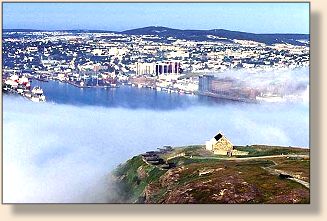
Text and Photos By Paul Smith and Ian Gall
Pond Fishing
The numerous ponds within St. John's city limits are also productive places to fish.
There is a surprisingly high probability of hooking a trophy fish considering you
are fishing in a metropolis of 120,000 people. Incidentally, don't be misled by the
term 'pond.' In Newfoundland, most small to medium bodies of water are called
ponds. To qualify as a lake here on The Rock, a body of water has to be big. Only
the larger bodies of water in central Newfoundland we call lakes: Grand Lake, Red
Indian Lake and Gander Lake are all in excess of 20 miles long. We have a Ten Mile
Pond in Northern Newfoundland!
Rainbow trout from California were imported in the 1880s and are still found in about
a dozen ponds to the north of the city, a mere 25 minute drive from downtown. These
are hard fighting as well as challenging fish and provide great sport for the urban angler.
Big hatches of Hexegenia Mayflies on warm summer evenings will bring the fish to the
surface, when a #6 White Wulff can be deadly.
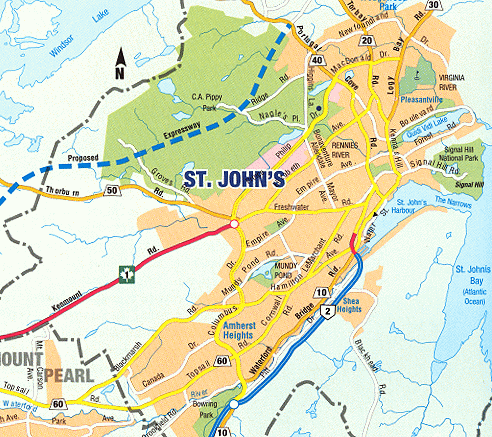
Long Pond, Kent's Pond, and Kenney's Pond, all close to Memorial University, hold
healthy populations of brown trout with the occasional specimen reaching double
digits. Mundy Pond nearer the older part of the city holds some very big browns.
The average size is about a pound, but fish up to 3 lbs are caught frequently by
local flyfishers ,and specimens in excess of 10 lbs have been observed. Most of
the time these fish are not too selective and can be caught on a variety of standard
trout flies - wets, dries and streamers.
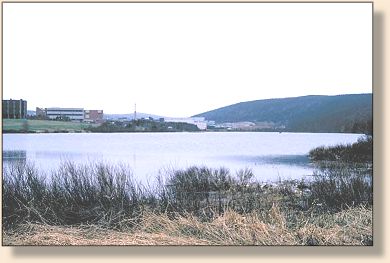
Mundy Pond
Mundy Pond is a favorite of many local anglers. It is located right in the middle
of the city and has a very large brown trout population. There is a walking trail
all the way around the pond making it easily accessible, even for the less physically
capable angler. Mid-May to early September is the best time to fish here. The
Muddler Minnow, Marabou Streamers and leech patterns are particularly very
effective in early season. As the season progresses into summer, many anglers
move to old standby wet trout patterns such as the Silver Doctor, Queen of the
Waters, and Black Gnat in sizes 10 to 16. During warmer periods CDC and Midge
emergers, as well as dry flies such as the Adams and Black Gnat are popular.
Caddis patterns, both adult and pupa are effective throughout the season.
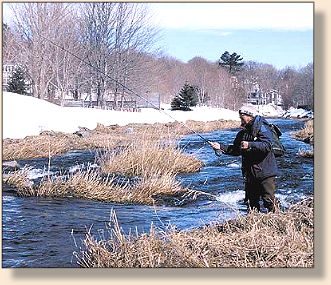
There is an interesting and maybe unique characteristic to the Mundy Pond
ecosystem. Some of the trout spawn underground and in complete darkness.
The outflow from the pond has been covered over and houses and buildings
erected above it, and the outflow channeled into the Waterford River via a large
underground pipe. An inspection pipe a few years ago revealed a blockage and
a quantity of gravel several hundred yards down from the pond. Trout were
spawning in the gravel!
Mundy Pond is a great place for visiting fly fishers. The pond is right in the middle
of the city and is very accessible even if you are without your wading or hiking gear.
All you really need is a rod and some flies. Fishing pressure is light, and there is a
real chance of hooking a trophy Brown.
Equipment
Three to five weight rods are adequate in St. John's rivers, although a six-weight
might provide a measure of security in the event of hooking a large fish. Long leaders
are essential due to the wariness of both Browns and Rainbows. Bring your wading
gear if you plan to fish the rivers. The banks get grown in with long grass and mobility
is best achieved with waders. A general stealthy small river approach should work
just fine. The ability to roll cast is a big advantage in many areas due to steep
riverbanks and overhanging trees. If you choose to fish the ponds, you can
get by with your running shoes and fish from shore, or you can use some sort
of boat. Float tubes or pontoon boats would be ideal.
Other Attractions
St. John's is rapidly turning into a tourist destination in addition to being the center
of Newfoundland's Offshore Oil and Gas Industry. Cruise liners, once rare visitors
to the city, are now a common sight from summer to fall.
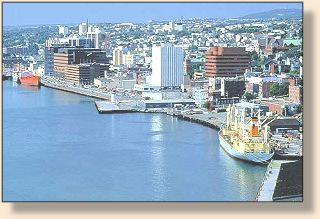 There are art galleries and museums that portray and interpret Newfoundland's
long and rocky road to the millennium. There are restaurants and eateries that
do justice to Newfoundland's culinary tradition. Our fish and chips are second
to none.
There are art galleries and museums that portray and interpret Newfoundland's
long and rocky road to the millennium. There are restaurants and eateries that
do justice to Newfoundland's culinary tradition. Our fish and chips are second
to none.
George Street, close to the major downtown hotels, is famous for its nightlife and
music. The entire street is lined with clubs and restaurants and during party time
is closed to traffic, reverberates instead to Blues, Irish, Scottish, and Newfoundland
music. Visiting anglers can stagger from George Street to the Waterford River and
be fishing for trout in a mere fifteen minutes.


For whatever reason you are in St. John's, a trip on one of several sailing vessels
from the harbor to Cape Spear is a must. Humpback, Fin and Minke Whales are
often spotted on the run to this most easterly point in North America. Sea birds
abound and the rugged coastline is simply magnificent. Whales often frequent
the entrance to the harbor and can be seen from Signal Hill, where Marconi
received his first trans-Atlantic wireless message in 1901. Signal Hill provides
an almost aerial view of the city, a panoramic ocean view, and is steeped in
military and technological history. From Signal Hill you can walk to the Queen's
Battery where the British installed an impressive canon battery over the harbor
entrance to deter French ships. As a fly fisher you will want to visit the Fluvarium.
This is a freshwater interpretation center that details all the marine life in the
St. John's ecosystem. You will find out all about where the trout you are
catching came from. In St. John's, even the trout have a colonial history. ~ Paul and Ian
|

